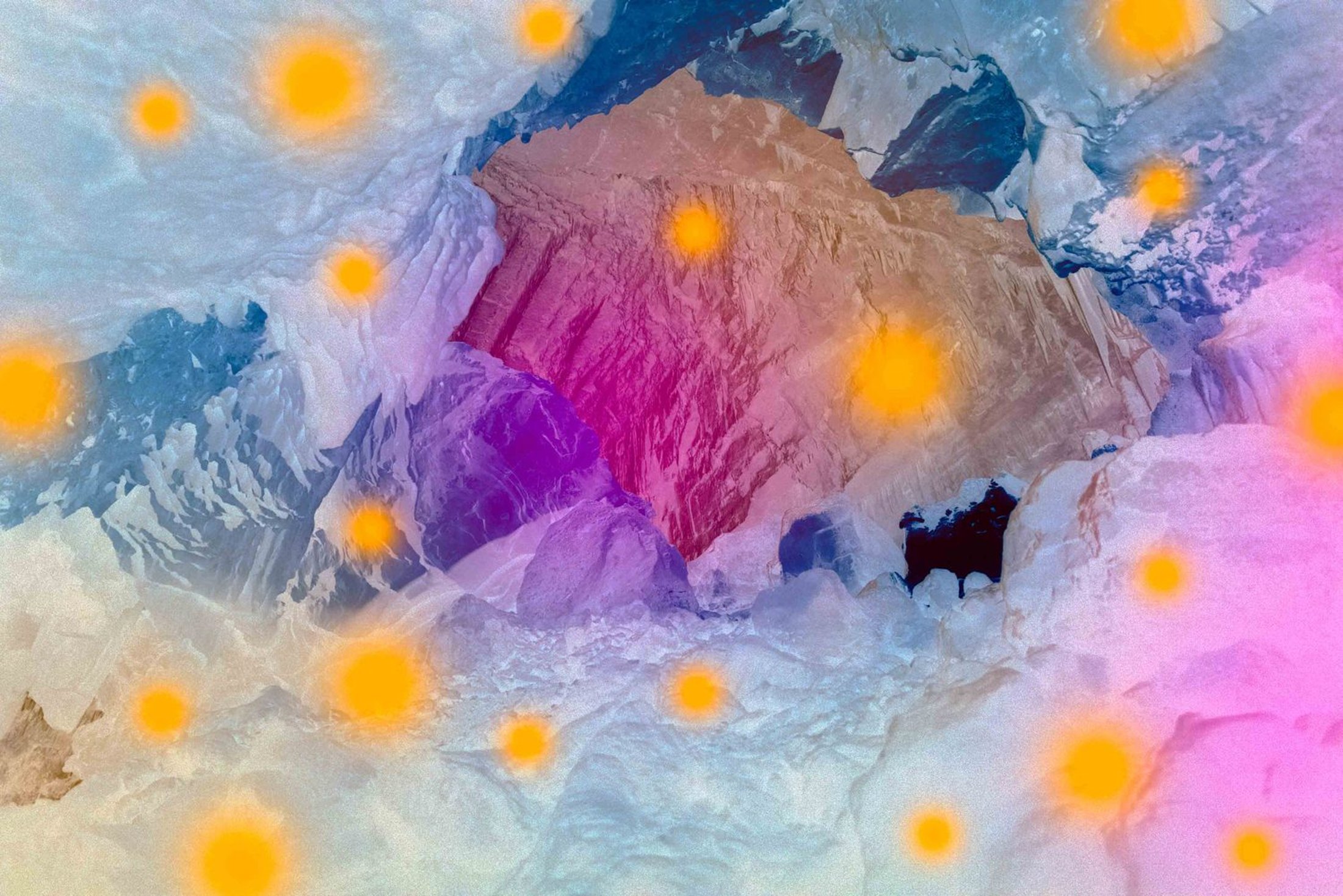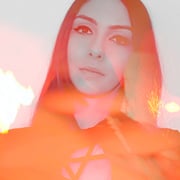Vibrating in a psychedelic color palette, Claudia Fuggetti’s bright visions of the world we live in seem otherworldly. And that’s almost the point. Fuelled by a deep concern and care for the natural world, the Italian artist is in search of a new visual language that shimmers with the vibrant life of the environment; one that invites us to perceive it in an altered way; as a living entity that we are part of rather than a picturesque backdrop we objectify.
Each of the images that make up Metamorphosis is a carefully-constructed invitation to contemplate the “regenerative and pulsating potential at the heart of the Earth.” As an artist who came of age during the early days of social media (Fuggetti’s love of photography first blossomed in the digital landscape of sites like Myspace) she has a view on how technology can be used in this important crusade. Her heavily-staged images ask: can it be a tool that connects us to our surroundings rather than alienating us?
In this interview for LensCulture, Fugetti speaks to Sophie Wright about her influences, building bridges between nature and technology and finding possibilities for renewal in our difficult times.

Sophie Wright: What are the main themes that keep you up at night as an artist?
CF: They revolve around the future of artificial intelligence and technology, as well as the pressing issue of climate change. The rapid advancements in AI and tech raise profound questions about the nature of creativity and human agency. I find myself wondering how these technologies will shape the future of art and our relationship with it. Will they enhance our creative capabilities, or will they overshadow the human touch that brings authenticity to artistic expression?
Equally concerning is the escalating climate crisis. The urgent and tangible effects of climate change stir a deep sense of anxiety within me. I worry about the future of our planet and how the environmental impact will affect not only the physical world but also the themes and subjects that artists like myself explore. The destruction of natural landscapes and ecosystems is not just a backdrop for artistic expression but a poignant subject that calls for urgent reflection and action. These concerns intertwine in my work, driving me to explore how technology and environmental issues intersect and influence one another.

SW: How does Metamorphosis fit into your journey?
CF: The project emerged during a residency in Altamura, a location near my hometown, Taranto. During this period, I deeply reflected on nature’s capacity for regeneration as the area was suffering from severe fires. This event had a profound impact on me, particularly because the affected areas are also tourist destinations, which led me to think about how we perceive nature.
My focus on environmental issues is not incidental. My hometown, although aesthetically beautiful, is overshadowed by an industry that produces dioxins and contributes to serious illnesses like cancer. I personally experience the challenge of dealing with this disease in my family, and the awareness that we cannot control air pollution has deeply affected me. Pollution is closely linked to climate change and, more broadly, to environmental protection.
Compared to my previous project, Hot Zone, this new work represents both a continuation and an evolution in my practice. Both projects use color to expressively capture the landscape, but Metamorphosis delves more deeply into themes of environmental change and the perception of nature, expanding my artistic dialogue on issues of significant social and environmental relevance.

SW: You mention a quote by ecologist David Abram in your statement who talks about the ‘crisis of perception’ that we are faced with today. How would you describe your own search for a new way to talk about the times we are living through?
CF: These words have profoundly inspired me because they prompted me to reflect on our relationship with nature. Often, it is a mere ‘object’ to us. On social media, images of picturesque places become commodities, and there is a lack of genuine respect and connection with the environment. We no longer regard nature as a living entity but rather as something external to us.
In addition to Abram’s perspective, the work of Timothy Morton has also influenced my thinking. In The Ecological Thought and Hyperobjects, Morton explores the idea of ‘hyperobjects’—entities so vast that they exceed our immediate comprehension. He proposes a new view of nature, not as an external, distant entity but as something intrinsically interconnected with us, to create a new ecological awareness. As an artist, my goal is to evoke a deeper sense of connection and reverence for the natural world.

SW: Though their message is very much to do with drawing attention to our physical world, your photographs are almost otherworldly. Was it important for you to be engaging with your local surroundings or were you looking for awe-inspiring locations?
CF: In creating my photographs, I navigate between engaging with local surroundings and seeking out awe-inspiring locations. My process begins with thorough research and mental preparation. I create detailed mental images of what I hope to capture, aiming to translate these visions into tangible photographs.
However, the beauty of photography lies in its ability to surpass initial expectations. Often, reality exceeds my preconceived ideas, presenting unexpected elements that can radically alter the final outcome. This element of surprise is one of the most fascinating aspects of my approach. Unplanned moments and unforeseen details that emerge during a shoot often lead to some of the most compelling images.
A concrete example of this is present in my photograph Cardi. When you zoom into this image, you can observe a delicate spider web and a small spider—details that were not part of my initial plan but that add to it. It’s these small, unexpected surprises that make me truly happy and enrich my creative process.

SW: How does this play out in the post-production stage of Metamorphosis?
CF: There is a continuous dialogue between anticipation and discovery. After capturing the images, the real magic happens when I review them on my computer at home. This stage allows me to rediscover the scenes through a new perspective, appreciating how unforeseen details have woven themselves into the final composition. This interplay between preparation and spontaneity makes photography a continually evolving and deeply rewarding practice for me.
SW: I’m curious about the shooting process for you, precisely because a lot of the awe and wonder must arrive when you’re back home with your editing tools. How did you choose your subjects and how did you cultivate your own sensitivity towards the scenes you photographed?
CF: Before starting a shoot, I carefully study the location and try to bring my ideas to life. I often use fixed lights and flashes of various colors to achieve part of the final result even during the shooting phase. For me, post-production is a moment when the images reveal themselves, in another way. I often get lost in the post-production process, listening to music and beginning to imagine the possibilities that the photographed image can offer. Since I was a teenager, I have always loved exploring new possibilities, colors, shapes, and representations through post-production, and I became passionate about software like Photoshop when I was just 15.

SW: Can you elaborate on your “chromatic interventions”? What brought you to this psychedelic color palette?
CF: Color in my artistic practice carries an ambivalent significance. These chromatic interventions symbolize the presence of life that persists even in adverse environmental conditions, while artificial colors simultaneously highlight the consumption of natural resources: reality is perceived as manifold and changeable, fragmented and limited.
The palette stems from a desire to explore these dualities. The vibrant, almost surreal tones emphasize the presence of life amidst environmental degradation. This approach can be seen as a continuation of the tradition of using color to convey deeper meanings in art, much like the Fauves, who used exaggerated colors to evoke emotional responses and challenge perceptions of reality.
One of my photographic influences is John Divola, who uses colors and painterly marks to transform and reinterpret abandoned spaces, creating a dialogue between the natural and the artificial that resonates deeply with my work. Another significant inspiration was Aldous Huxley’s The Doors of Perception. Huxley’s exploration of altered states of consciousness and his vivid descriptions of enhanced perception deeply inform my use of color. His insights into how our minds can perceive reality in new and transformative ways inspire my efforts to use color to shift perspectives and reveal our environment’s hidden layers.

SW: An interesting encounter between the digital and the environment happens in your pictures. Do you think technology can bring us closer to our surroundings? Is it a tool or does it distance us further from our physical world?
CF: The intersection of the digital and the natural world fascinates and unsettles me at the same time. My work reflects a broader conversation about the role of technology in our relationship with the environment. It would be interesting to use technology in a way that coexists, rather than contrasts, with nature.
On the other hand, there are concerns that technology might also distance us from the physical world. In Simulacra and Simulation, Jean Baudrillard suggests that technology can produce a simulation of reality that diverts us from the true experience of the physical world, transforming our perception into a continuous play of images and signs. The concept of the Metaverse is also alienating, moving us increasingly into an intangible dimension.
Photography, in fact, represents this bridge between these two worlds. By integrating digital elements with environmental themes, I try to use technology as a means to enrich our appreciation of nature, rather than distancing us from it. The goal is to create a dialogue between the digital and natural realms, encouraging viewers to reflect on how technology can both challenge and enrich our connection to the world around us.

SW: Tell me about the presence of people in your images and their role in Metamorphosis.
CF: People feature more as an entity rather than as individuals. Humans are depicted as part of a larger, indivisible whole with nature, creating a sense of unity that is both inseparable and cathartic. These human figures often appear more as silhouettes or blurred presences, almost intangible and ethereal, blending seamlessly into the natural environment. By presenting humans in this manner, Metamorphosis aims to reflect on the profound connection between humanity and the natural world, suggesting that our existence is deeply woven into the fabric of nature itself.

SW: Your previous project Hot Zone was a confrontation with a difficult period of your life in which you were suffering from anxiety about the future and our environment. Do you feel you found a path forward in the approach you developed in Metamorphosis?
CF: Yes, Hot Zone was indeed a deeply personal project that emerged from a challenging period of my life, marked by anxiety about the future and environmental concerns. The project was a way for me to confront and articulate those fears through my art.
In Metamorphosis, I have found a more nuanced path forward. While Hot Zone focuses on the immediate, often overwhelming threats to our environment, Metamorphosis explores how images can change our general perception of nature and the world.
This allows me to engage with environmental issues through a lens of renewal and possibility, rather than solely through the anxiety that characterized Hot Zone. It represents a progression in my artistic journey, where I am not only addressing the crisis but also reflecting on the potential for positive change and regeneration. This evolution in perspective has provided a sense of clarity and purpose, helping me navigate my concerns about the future while still engaging critically with the environmental issues that are so important to me.





















